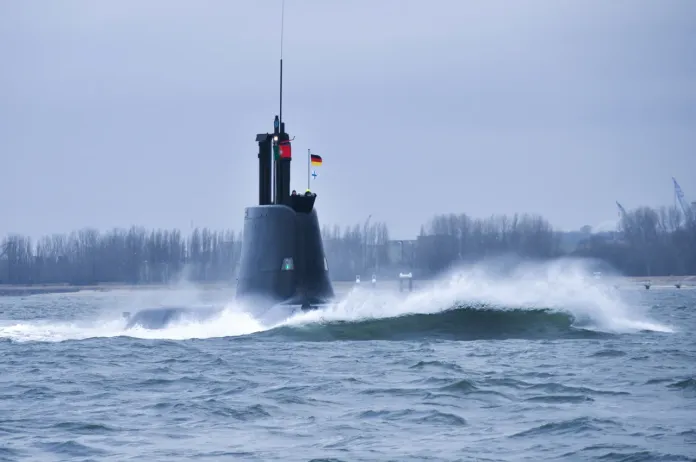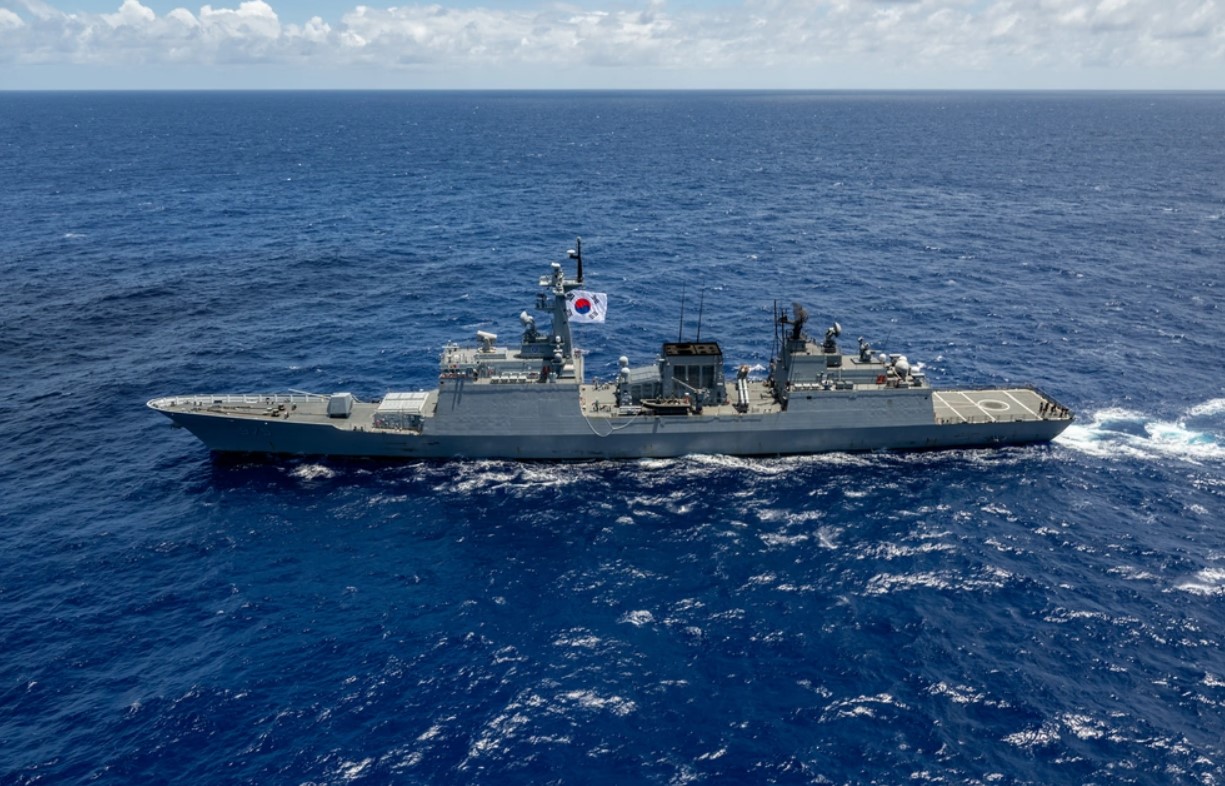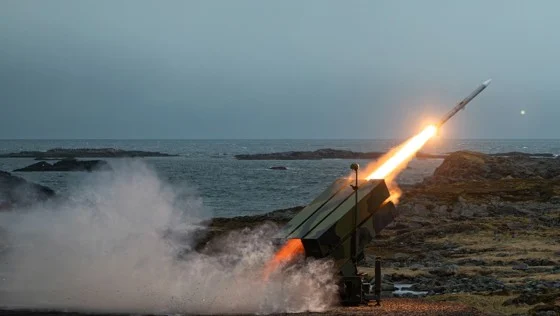The Indian government is expected to formally sign an agreement with the German company ThyssenKrupp Marine Systems (TKMS) in the next few months for the supply of six Type 214 diesel-electric attack submarines (SSKs). The ambitious project, which costs around 70,000 crore Indian rupees, is part of the Indian Navy’s effort to augment its underwater capabilities in the Indian Ocean Region (IOR). Project 75-I was launched to acquire next-generation SSKs for the Indian Navy in the late 1990s. It was a successor to the Project 75, under which India acquired six Scorpene-class submarines from France, which were inducted into the Indian Navy as the Kalvari-class SSKs.
The Type 214 submarine is an export variant of the Type 212. It has a submerged displacement of about 1,860 tons. It has a diving depth of 400 meters, which enables it to remain undetected by the adversary’s sensors. The submerged platform features eight torpedo tubes, four of which are equipped with a water ram expulsion system, enabling them to fire anti-ship missiles. Its weapons package will include Harpoon anti-ship missiles, along with the indigenously developed Varunastra Torpedo, which has a speed exceeding 38 knots. These systems, together, make the Type 214 a formidable platform because they enable it to engage both ships and submarines with enhanced precision at extended ranges in less duration.
The submarine can re-adjust its electronic signature, allowing it to reduce its chances of detection at regular intervals, thereby enhancing survivability. Type-214 is integrated with the Torpedo Countermeasures (TCM) system, which allows it to deceive the torpedoes fired upon it by the adversary’s surface, sub-surface, and air-borne platforms. As far as electronic weapons systems are concerned, TKMS will jointly build them with its Indian partner. Moreover, the submarine features an HDW Fuel Cell air-independent propulsion system (AIP), which significantly enhances underwater endurance for up to 14 days and reduces the risk of detection because it lacks major moving parts that could compromise acoustic stealth. Along with improvements in hull design, it has a low-noise propeller to lower the submarine’s acoustic signature.
TKSM will build the Type 214 submarines in India in a joint venture with Mazagon Dock Shibuilders Limited (MDSL). They will be built at the MDSL facility in Mumbai. Both companies have already signed a “Concept Design Agreement” in August 2025, which suggests that the groundwork for the joint venture is complete. Following this, on September 11, 2025, the project entered the next phase in which both sides began negotiations for six SSKs under the Make in India initiative. Once this phase is completed in the next few months, both parties will formally sign the agreement, marking the commencement of submarine construction.
Comparison of German Type 214 vs Existing Kalvari Class Submarines.
| Characteristics | Type 214 Class | Kalvari Class |
| Complement | 27 | 31 |
| Displacement (Surface) Tons | 1,860 | 1,775 |
| Speed (Kn) | 12 surfaced: 20 dived | 11 surfaced: 20 dived |
| Mission Endurance (Days) | Up to 84 | 50 |
| Submerged Endurance (Days) | 14 | 14 |
| Test Depth (m) | 400+ | 350+ |
| Range (nm) | 12,000 at 8 kt surfaced | 6,500 at 8 kt surfaced |
| Torpedo Tubes | 08 | 06 |
| Missile Firing Capability | Yes | Yes |
| Weapons Storage Capacity | 16 (torpedoes, missiles, mines) | 18 (torpedoes, missiles, mines) |
| AIP | Yes | Yes |
Source: Author’s Own Compilation by data collection from multiple sources.
It is expected that the contract will be signed for nine submarines instead of six, because the Indian Navy is reportedly considering canceling its contract with the French company Naval Group, which was awarded a contract to build three additional Scorpene-class submarines earlier. This could likely be the case because the Type 214 SSKs are generation ahead of the Kalvari-class SSKs. Moreover, it will ease things for the MDSL because constructing two different class SSKs is a complex task. However, there remains a small caveat, as the Indian government may allow the deal with France to proceed because, at present, when India is facing diplomatic setbacks from the US and its Middle Eastern allies following the May 2025 clash with Pakistan, France is currently standing by India.
The center of gravity of naval activities in the present epoch has been shifted from the high seas to the littorals. The littoral zone has a highly complex environment, characterized by shallow waters and proximity to shores. Type 214, with its ability to conduct missions in littoral waters, will offer significant advantages to the Indian Navy. While operating in littorals, it can conduct various tasks, including photo intelligence, electronic reconnaissance, signal intelligence, cable tapping, rehearsals for underwater demolition and special operations teams in adversary’s coastal waters, locating hiding spots using data collected by survey ships, and finding new ways to enter enemy territory.
On four occasions in the past (2016, 2019, 2021, and 2022), the Indian submarines have tried to intrude into Pakistan’s maritime waters. The Indian Navy carried out these spy missions to gather intelligence data (electronic, photographic, and signal intelligence) and identify new safe routes for infiltration without alerting Pakistan. However, with the 24/7 vigilance demonstrated by the Pakistan Navy, these intrusion attempts were successfully thwarted. These interceptions not only compelled the Indian submarines to abandon their mission, but Pakistan Navy’s platforms also recorded the electronic and acoustic signatures of these submerged platforms. This means that whenever they come within the range of Pakistan’s naval sensors, they will be easily identified.
Considering this, the induction of the next-generation Type 214 in the coming years will be a boost to India’s submerged capabilities as this submarine is considered to be advanced than all submerged platforms currently operational with the Indian submarine force. Given this, these advanced submarines are likely to remain under the operational command of the Indian Navy’s Western Naval Command, headquartered in Mumbai. This will increase the threat perception for Pakistan in the future because the Western naval command is Pakistan-centric. To keep them at bay, the Navy can invest in acquiring additional long-range, extended-endurance manned and unmanned fixed- and rotary-wing airborne platforms equipped with an acoustic sensor suite, sonobuoys, and advanced SAR radar. These capabilities will enable the Pakistan Navy to detect them both at periscope depth and underwater.

Usman Haider
Usman Haider is an independent researcher and MPhil graduate from the Strategic Studies department, National Defense University, Islamabad. Previously, he worked at two think tanks in Islamabad, Pakistan: the Strategic Vision Institute (SVI) and the Center for Aerospace and Security Studies (CASS).
- This author does not have any more posts.












